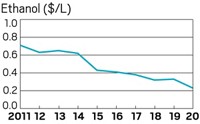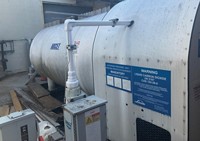Advertisement
Grab your lab coat. Let's get started
Welcome!
Welcome!
Create an account below to get 6 C&EN articles per month, receive newsletters and more - all free.
It seems this is your first time logging in online. Please enter the following information to continue.
As an ACS member you automatically get access to this site. All we need is few more details to create your reading experience.
Not you? Sign in with a different account.
Not you? Sign in with a different account.
ERROR 1
ERROR 1
ERROR 2
ERROR 2
ERROR 2
ERROR 2
ERROR 2
Password and Confirm password must match.
If you have an ACS member number, please enter it here so we can link this account to your membership. (optional)
ERROR 2
ACS values your privacy. By submitting your information, you are gaining access to C&EN and subscribing to our weekly newsletter. We use the information you provide to make your reading experience better, and we will never sell your data to third party members.
Energy
Researchers Explore Food-Grade Ethanol
Goal is to fine-tune alcohol purification and reduce the cost of production
by Glenn Hess
August 31, 2006

Two Iowa State University (ISU) professors are working to find a way to dramatically cut the cost of converting fuel ethanol into the higher value food-grade alcohol that is an essential ingredient in adult beverages, cough syrups, mouthwashes, and other personal care products.
Jacek Koziel, an ISU assistant professor of agricultural and biosystems engineering, recently launched a research project that aims to combine two technologies–ozone gas and carbon filtration–to efficiently remove the impurities in fuel ethanol.
"In this research, we are really trying to fine-tune the process," says Koziel. "We are not ready for commercial-scale application yet. But if this is viable, we are looking at adding a lot of value to relatively cheap fuel-grade ethanol."
Ethanol is big business in Iowa, which is the nation's top corn grower. Currently, the state has 25 ethanol refineries with the capacity to produce nearly 1.6 billion gal annually. Seven plants under construction or expansion will add another 475 million gal of annual capacity.
Hans van Leeuwen, an ISU professor of civil, construction, and environmental engineering, says the corn-based fuel ethanol that is used primarily as a gasoline additive is similar to the purer food-grade product.
For either type, ethanol is produced by yeast fermentation and then distilled. But the numerous distillations required to manufacture the food-grade product are energy-intensive and increase production costs by about 50 cents per gal.
The technologies that ISU scientists are working to perfect could purify fuel ethanol into food-grade alcohol for less than 1 cent per gal, according to van Leeuwen. "Based on my experience treating water and wastewater with these technologies, this could cost a lot less than a cent per gallon," he says.
Koziel says the researchers are using two different purification technologies. "First, we are bubbling ozone through a column of alcohol and letting the ozone react with the alcohol and the impurities," he says. "The second step is to use granular activated carbon to selectively remove some of those impurities, as well as the products of reaction."
From an engineering standpoint, van Leeuwen says, it would be easy and inexpensive to add to an ethanol plant a unit that carries out these two steps. "This is a relatively minor investment, and of course, it adds value to the product," he remarks.
Following the phaseout of methyl tert-butyl ether (MTBE) earlier this year, producers of fuel ethanol are enjoying record demand and expect to produce more than 4 billion gal in 2006. By comparison, the food-grade alcohol market is only about one-sixteenth that size, according to van Leeuwen.
But the ISU professors believe that food-grade ethanol has the potential to become a profitable, premium business, with the beverage, pharmaceutical, and personal care areas providing steady demand.
"A quarter of a billion gallons is still a lot of ethanol," van Leeuwen says about the annual demand for food-grade ethanol. "And if you can save 49 cents on each and every gallon, you're looking at about $120 million in savings every year. I think that makes it worthwhile."
Another potential outlet is the export market. Because food-grade ethanol tastes a lot like vodka, van Leeuwen says, some Iowa companies are already selling the higher grade alcohol to vodka producers in Russia. "We can grow corn so efficiently around here; apparently, we can even compete in markets like Russia," he says.




Join the conversation
Contact the reporter
Submit a Letter to the Editor for publication
Engage with us on Twitter